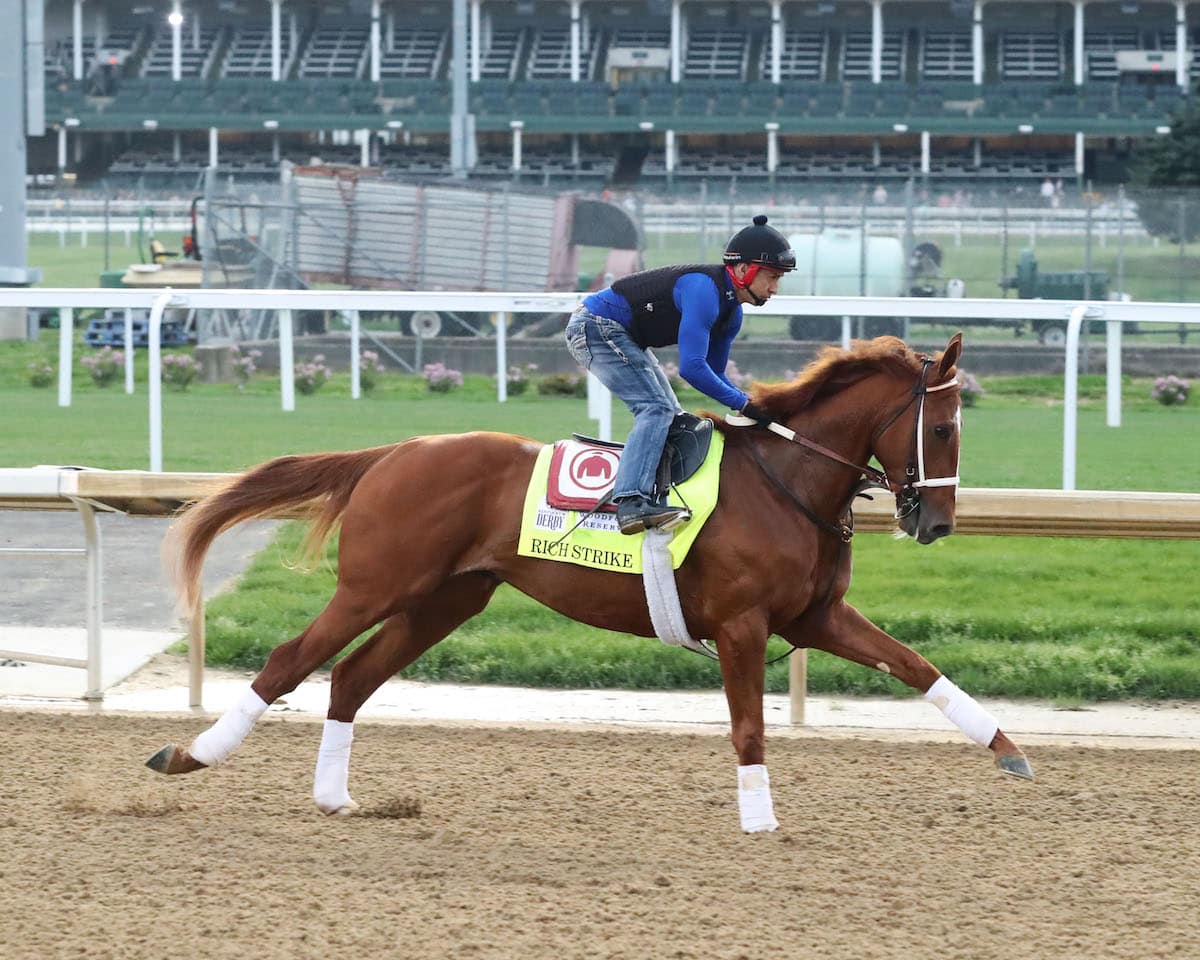
After would-be Kentucky Derby victor Rich Strike ran 10th in his first race as a 2-year-old, owner/breeder Calumet Farm entered him in a $30,000 claiming race. Trainer Eric Reed claimed Rich Strike for current owner RED TR-Racing. Courtesy Coady Photography
If every time you entered your green OTTB into a jumper division, he had to face a grand prix horse, you would get discouraged pretty quickly. How could you possibly defeat a pair with that much more experience and ability? It certainly wouldn’t be fair.
That’s why horse shows have levels. Competitors can tackle the level that suits both horse and rider. It’s equitable and provides more opportunities for everyone.
Horse racing also has levels, often decided by the amount of money awarded to the winner of a race. But if an owner entered his or her Kentucky Derby winner in a lesser race just to pick up some extra cash, would that be fair to owners of the other horses in the race?
While that’s an extreme example, horse racing almost from its inception had to find a way to make each race competitive, both for the owners of the horses and for the people who bet on them. Sometimes that means restricting races to horses of a certain age or ability, but often it’s done through claiming races.
Claiming races at their most basic mean any horse in the race can be “claimed” or sold for a specific price. The idea is each horse entered is worth that amount — no more and no less — so theoretically they are all equal in ability.
Say you think your racehorse is worth $5,000. If you run him in a $1,000 claiming race, where any horse can be purchased for $1,000, you might win the race because your horse is worth five times more than his competition. But someone is likely to buy your horse for $1,000. Under the race’s rules, you must sell him, and you’d lose $4,000 of his value.
If you run that same horse for a $10,000 claiming price, no one is likely to buy him at twice what he’s worth. But because he’s running against horses twice as good as he is, he’ll probably lose the race.
Run him for $5,000, however, and your horse will be running against equal competition with a good chance to win and, if someone does claim him, you’ll receive the true value of the horse.
And here’s another incentive: That claim must be put in before the race is run and the new owner doesn’t get the horse until after the race. Thus, the original owner wins any money the horse earns in the race, and the prospective buyer doesn’t have the advantage of seeing if the horse can win the race before deciding to purchase him.
Eddie Truman is a longtime trainer based in Southern California. He has trained such stakes winners as Go West Marie, a mare who earned $557,520, much of it under his tutelage. But he has also made money for owners through claiming races.
“With our purses so much better these days, you can claim a horse and maybe drop him down a level and still make money,” Truman says. “To run him back at the same level and win would be fantastic.”
Even better are those occasions when an owner and trainer find an improving horse, claim him and move him up in class. This year’s Kentucky Derby provided a textbook example. After Rich Strike ran 10th in his first race as a 2-year-old, owner/breeder Calumet Farm entered him in a $30,000 claiming race. Trainer Eric Reed claimed Rich Strike for owner RED TR-Racing, and Rich Strike won by 17 ¼ lengths. The colt ran well in five subsequent (and more competitive) races but didn’t win until his surprising victory in the Derby.
Most of the time a horse like Rich Strike would never run in a claiming race. But Truman points out that looking for a young horse with plenty of potential is a good plan when claiming horses, a strategy that definitely worked well for Reed.
“I like those young horses because they keep growing through their 4-year-old year,” said Truman. “I also look for a horse that’s maybe sprinting but is bred to run long or the way he runs shows that he might want to stretch out.”
Typically, trainers begin a young horse’s racing career in shorter races. If a horse’s parentage indicates he might be better at longer distances, a trainer might be able to claim that horse early in his career and then successfully move him into better races at longer distances. Rich Strike likes to lag well back early and make his run at the end, which worked better at the Derby’s 1 ¼-mile distance than it did earlier in his career when he was running in shorter races.
The concept is similar to off-track Thoroughbreds that weren’t successful racehorses but found their calling in another sport. Take Divine Fortune, who began his racing career in a sprint claiming race on the dirt at Delaware Park in 2006. Nobody claimed him for $50,000, which looked smart because he ran a poor sixth, beaten by more than 10 lengths. It turned out Divine Fortune preferred racing over jumps on the grass. He became the nation’s champion steeplechaser in 2013 by winning such races as the Grand National Hurdle Stakes at Far Hills in New Jersey over 2 5/8 miles on the grass.
While it took Divine Fortune seven years to develop into a champion, a major advantage to claiming races is they can be one of the least expensive and fastest ways to become a racehorse owner. Instead of buying a yearling or a 2-year-old and waiting for him to mature, learn all his lessons and train long enough to be race-fit, an owner can claim a horse already racing and own him for his next start, which could be in just a couple of weeks.
“It can get somebody in the business with a relatively small investment,” said Truman. “They don’t have to wait on a horse. It’s a good way to get in the business, get their feet wet and see if they like it.”
Horses’ values aren’t always tied strictly to their racing ability. Breeders might see a filly with attractive bloodlines and, because they want to turn her into a broodmare, will pay more than she might be worth as a racehorse. Likewise, if a hunter-jumper trainer saw a horse that appeared to be suited to that career, a claim might be worth it.
Claims aren’t available to just anyone, however. Usually, racetrack rules specify that only licensed racehorse owners can put in claims. That owner must also have a trainer because as soon as the race ends, ownership changes. Racetracks want to ensure any claimed horse has a place to go after the race, with a trainer to care for it.
One danger in claiming is a trainer could drop a sore horse into a claiming race worth much less than the horse’s value in the hope someone will claim him. California is one of many racing jurisdictions that has instituted a rule that voids a claim if the official veterinarian deems that horse to be unsound. In addition, states such as California have rigorous pre-race veterinary checks, and horses that don’t pass them are not allowed to compete.
Owners and trainers often spend large amounts of time watching videos of races to find a horse they want to claim. They can also examine the horse visually in the paddock before the race.
Sometimes more than one owner and trainer want to claim a horse. In those cases a “shake” is performed to see who gets him, so called because the blind draw is usually performed by putting numbered pills in a bottle, shaking them up and drawing one out. The person associated with the winning pill gets the horse.
One of the most fortuitous shakes occurred with the horse Unusual Heat at Hollywood Park in 1996. Trainer Barry Abrams and an ownership partnership headed by James Auerbach won the shake, getting Unusual Heat for an $80,000 claim. Abrams and the Auerbach family stood Unusual Heat at stud in California, and the horse turned into one of the state’s finest stallions.
The chance to find the next Rich Strike, Divine Fortune or Unusual Heat is part of the fun of claiming. But even if your claim doesn’t nab you a superstar, it might get you to the winner’s circle after the very next race.

